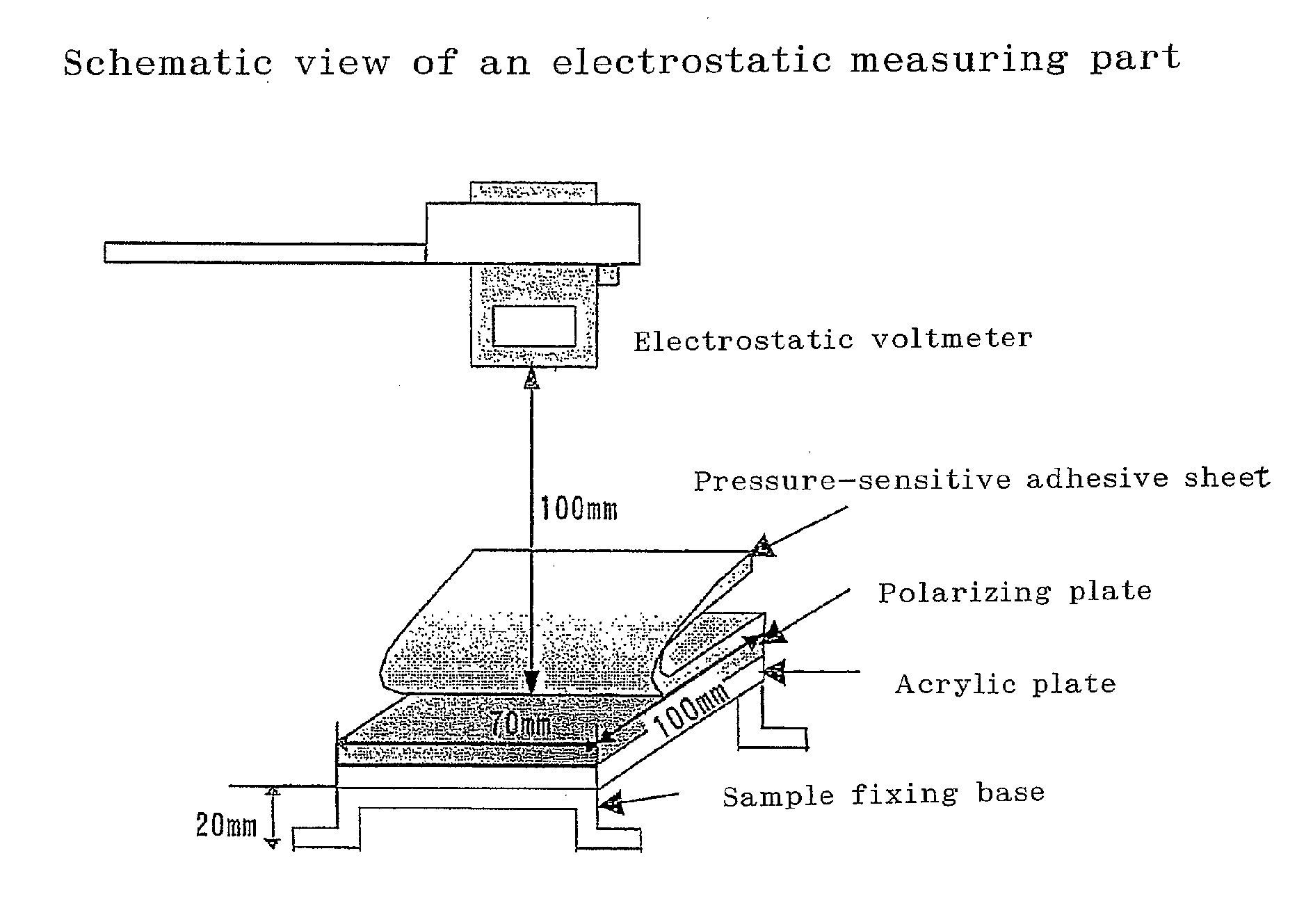Adhesive composition, adhesive sheet, and surface protective film
a technology of adhesive composition and adhesive sheet, which is applied in the direction of film/foil adhesives, metal layered products, synthetic resin layered products, etc., can solve the problems of static electricity, high electrical insulation properties, and inability to align liquid crystal molecule, so as to improve the peeling electrification voltage of the adherend, improve the heat resistance and weather resistance, and reduce the staining property
- Summary
- Abstract
- Description
- Claims
- Application Information
AI Technical Summary
Benefits of technology
Problems solved by technology
Method used
Image
Examples
example 1
Preparation of Adhesive Solution
[0206]The Acrylic Polymer (A) solution (35% by weight) was diluted to 20% by weight with ethyl acetate. To 100 parts by weight of the resulting solution were added 2 part by weight of the antistatic agent solution (a) (10% by weight), 0.4 parts by weight of an isocyanurate of hexamethylene diisocyanate (Coronate HX manufactured by Nippon Polyurethane Industry Co., Ltd) as a crosslinking agent, and 0.4 parts by weight of dibutyltin dilaurate (a 1% by weight ethyl acetate solution) as a crosslinking catalysis, and mixing and stirring were performed at room temperature (25° C.) for about one minute so that an acrylic adhesive solution (1) was prepared.
(Production of Adhesive Sheet)
[0207]The acryl adhesive solution (1) was applied on the opposite surface of the above-mentioned antistatic-treated film to the antistatic-treated surface, and heated at a temperature of 130° C. for 2 minutes to form a pressure sensitive adhesive layer having a thickness of 20 ...
example 2
Preparation of Adhesive Solution
[0208]The Acrylic Polymer (B) solution (35% by weight) was diluted to 20% by weight with ethyl acetate. To 100 parts by weight of the resulting solution were added 2 part by weight of the antistatic agent solution (b) (10% by weight), 0.4 parts by weight of an isocyanurate of hexamethylene diisocyanate (Coronate HX manufactured by Nippon Polyurethane Industry Co., Ltd) as a crosslinking agent, and 0.4 parts by weight of dibutyltin dilaurate (a 1% by weight ethyl acetate solution) as a crosslinking catalysis, and mixing and stirring were performed at room temperature (25° C.) for about one minute so that an acrylic adhesive solution (2) was prepared.
[0209]A pressure sensitive adhesive sheet was prepared using the process of Example 1, except that the acrylic adhesive solution (2) was used in place of the acrylic adhesive solution (1).
example 3
Preparation of Adhesive Solution
[0210]The Acrylic Polymer (C) solution (40% by weight) was diluted to 20% by weight with ethyl acetate. To 100 parts by weight of the resulting solution were added 2 part by weight of the antistatic agent solution (a) (10% by weight), 0.4 parts by weight of an isocyanurate of hexamethylene diisocyanate (Coronate HX manufactured by Nippon Polyurethane Industry Co., Ltd) as a crosslinking agent, and 0.4 parts by weight of dibutyltin dilaurate (a 1% by weight ethyl acetate solution) as a crosslinking catalysis, and mixing and stirring were performed at room temperature (25° C.) for about one minute so that an acrylic adhesive solution (3) was prepared.
[0211]A pressure sensitive adhesive sheet was prepared using the process of Example 1, except that the acrylic adhesive solution (3) was used in place of the acrylic adhesive solution (1).
PUM
| Property | Measurement | Unit |
|---|---|---|
| temperature | aaaaa | aaaaa |
| glass transition temperature | aaaaa | aaaaa |
| glass transition temperature | aaaaa | aaaaa |
Abstract
Description
Claims
Application Information
 Login to View More
Login to View More - R&D
- Intellectual Property
- Life Sciences
- Materials
- Tech Scout
- Unparalleled Data Quality
- Higher Quality Content
- 60% Fewer Hallucinations
Browse by: Latest US Patents, China's latest patents, Technical Efficacy Thesaurus, Application Domain, Technology Topic, Popular Technical Reports.
© 2025 PatSnap. All rights reserved.Legal|Privacy policy|Modern Slavery Act Transparency Statement|Sitemap|About US| Contact US: help@patsnap.com



